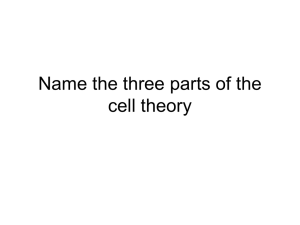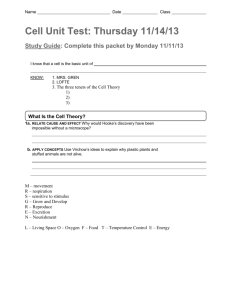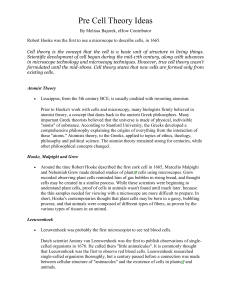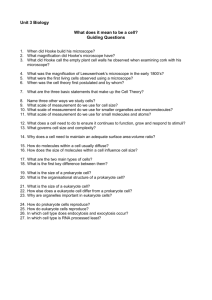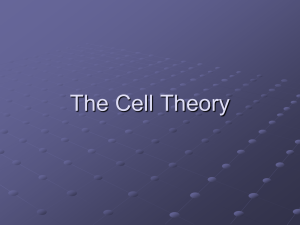Outline of Curriculum Module on History of Microscope
advertisement
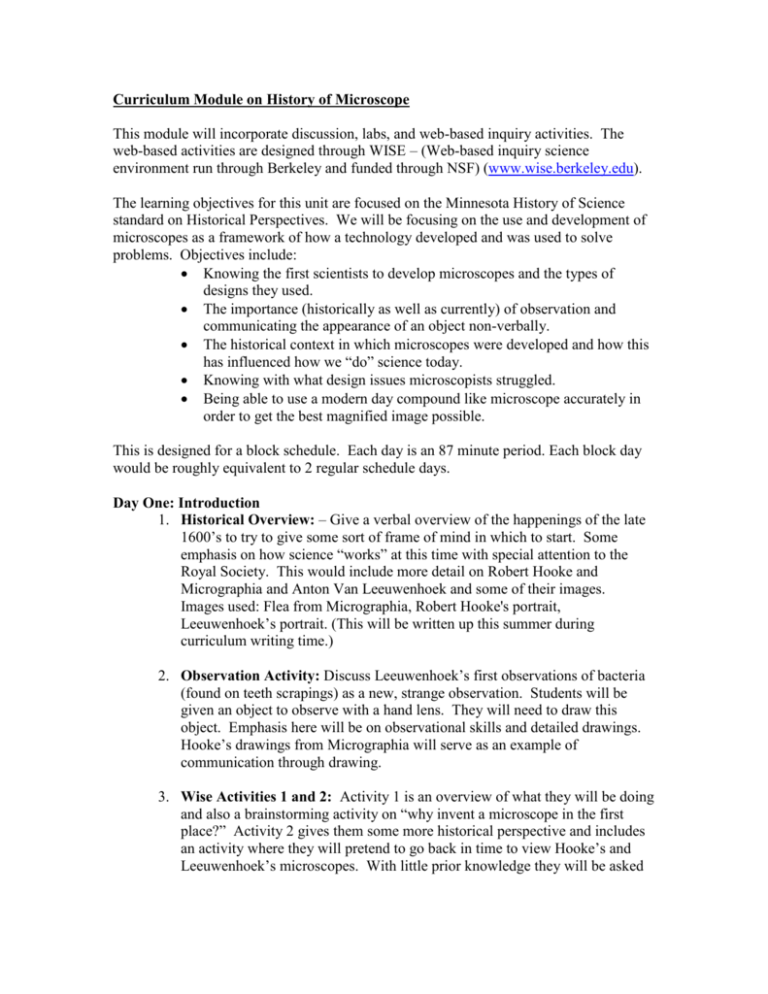
Curriculum Module on History of Microscope This module will incorporate discussion, labs, and web-based inquiry activities. The web-based activities are designed through WISE – (Web-based inquiry science environment run through Berkeley and funded through NSF) (www.wise.berkeley.edu). The learning objectives for this unit are focused on the Minnesota History of Science standard on Historical Perspectives. We will be focusing on the use and development of microscopes as a framework of how a technology developed and was used to solve problems. Objectives include: Knowing the first scientists to develop microscopes and the types of designs they used. The importance (historically as well as currently) of observation and communicating the appearance of an object non-verbally. The historical context in which microscopes were developed and how this has influenced how we “do” science today. Knowing with what design issues microscopists struggled. Being able to use a modern day compound like microscope accurately in order to get the best magnified image possible. This is designed for a block schedule. Each day is an 87 minute period. Each block day would be roughly equivalent to 2 regular schedule days. Day One: Introduction 1. Historical Overview: – Give a verbal overview of the happenings of the late 1600’s to try to give some sort of frame of mind in which to start. Some emphasis on how science “works” at this time with special attention to the Royal Society. This would include more detail on Robert Hooke and Micrographia and Anton Van Leeuwenhoek and some of their images. Images used: Flea from Micrographia, Robert Hooke's portrait, Leeuwenhoek’s portrait. (This will be written up this summer during curriculum writing time.) 2. Observation Activity: Discuss Leeuwenhoek’s first observations of bacteria (found on teeth scrapings) as a new, strange observation. Students will be given an object to observe with a hand lens. They will need to draw this object. Emphasis here will be on observational skills and detailed drawings. Hooke’s drawings from Micrographia will serve as an example of communication through drawing. 3. Wise Activities 1 and 2: Activity 1 is an overview of what they will be doing and also a brainstorming activity on “why invent a microscope in the first place?” Activity 2 gives them some more historical perspective and includes an activity where they will pretend to go back in time to view Hooke’s and Leeuwenhoek’s microscopes. With little prior knowledge they will be asked to try to figure out how the scopes work and how they might be historically important to this field. Day 2: Technical Issues of the Microscope 1. Review and share some of the reports from the microscope project from Activity 2. As an introduction to this sharing, the method of sharing will be discussed as a way in which scientists have spread information to others through organizations such as the Royal Society. This will give more meaning to the sharing as more than a pedagogical tool. 2. Lab: Lighting. Lighting is an issue that had to be overcome in the development of microscopes. To be able to clearly see an object the lighting had to be optimum. If lighting was substandard the microscope would not be able to show an image to its full potential. By giving the students the opportunity to develop their own conclusion about the lighting they will be working in much the same way early microscopists had to to solve design issues. Activity: Students will be given a sample to observe with a microscope. They will be asked to view the sample (prepared side or larger object if using a dissecting microscope) with lighting from different directions and different amounts. They will be given a second sample (this will be different from the first sample in terms of its color and shade intensity) to view in the same manner. Students must develop a conclusion about lighting (i.e. When do you want full light or less light, what direction does the lighting work best). 3. Wise Activity 3: Technical aspects of the microscope. Here students will delve into the issues of magnification and resolution as well the parts of a modern day light microscope. Day 3: Using a light microscope: 1. Review magnification and resolution from Day 2 Wise Activity. 2. Microscope Lab: This is the fairly traditional lab where the students work on magnification, the letter “e” observation to observe what the lenses do to the image, using fine adjustment to observe depth, as well as more emphasis here on observations and detailed drawings.(see attached) Day 4: Assessment Project: Using Hooke’s or Swammerdam’s images as a guide, create a coat of arms for the ruling family. Incorporate a small insect or object that you will observe in class as the focal point of the coat to show the family has power over the small and great. Background information will be given on the importance of patronage to science in the 1600’s. Funding of science has been an issue since this time. Today the funding sources may be different but not any less important. Discussion will involve the Barberini family and their coat of arms and also more modern day examples of funding. The observational part of this activity will need to done in class. The remainder of the project can either be assigned as out of class homework or class time can be given. Bibliography(This includes all the links for the creation of the WISE site): Freedberg, David. The Eye of the Lynx. University of Chicago Press: 2002. Hooke, Robert. Micrographica. 1665. (Reprinted by Dover Publications: New York, 1961.) Jardine, Lisa. The Curious Life of Robert Hooke: The Man who measured London. Harper Collins Publishers: 2004. http://www.microscopy-uk.net/mag/indexmag.html?http://www.microscopyuk.net/mag/articles/sepsnip.html http://www.ucmp.berkeley.edu/history/hooke.html http://swehsc.pharmacy.arizona.edu/exppath/micro/edu/education.html http://www.cas.muohio.edu/~mbi-ws/microscopes/resolution.html http://science.nhmccd.edu/biol/dropdrag/microscope2.htm http://www.usoe.k12.ut.us/curr/science/sciber00/7th/cells/sciber/micrpart.htm http://www.microscopy-uk.org.uk/index.html?http://www.microscopyuk.org.uk/intro/histo.html http://www.southwestschools.org/jsfaculty/Microscopes/fathers.html http://www.arsmachina.com/micro_1.htm http://micro.magnet.fsu.edu/primer/java/scienceopticsu/virtual/magnifying/index.html
